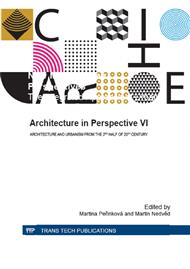p.72
p.79
p.88
p.93
p.97
p.101
p.107
p.115
p.122
The Beauty of Skylight
Abstract:
It is commonly claimed that the modern secularized society worships consumption and fetishism of things and that consumerism has become a substitute to religion. Is that still true Is our society really nonreligious Has not secularization exceeded the stage of atheism It might not need being defined to the old religion any more. Maybe again without remorse the new paganism indulges, for its faith is not ashamed. How are these trends reflected in architecture The paper presents details of a particular architectural work - skylight in an the Avion shopping center (Ostrava), as a case study, which analyzed and interpreted with help two opposite principles. It is also said that a hypermarket (English only knows the word: supermarket.) became a temple of consumerism. Temples traditionally used to have specific lighting - more of chiaroscuro. Windows allowed only little sunlight to enter, artificial light was imperfect. On to contrary a hypermarket has no windows - and the artificial light is even of better quality than the daylight. Still there is a skylight in a building of a shopping center. This modern temple is open to the sky, lets sunshine enter into the own inner. The skylight is shaped as a pyramid. Through skylight tradition meets with new practice: a popular symbol of free Masons is reinterpreted by nowadays builder/designer - steel rods have inverted bearing system, going from thin to thick profile. Skylight refers to himself - connects the earthly closed space with the air vertical (strengthens the axis mundi). It is an archaic work or on the contrary postmodern anachronistic
Info:
Periodical:
Pages:
97-100
Citation:
Online since:
November 2014
Authors:
Permissions:
Share:
Citation:


